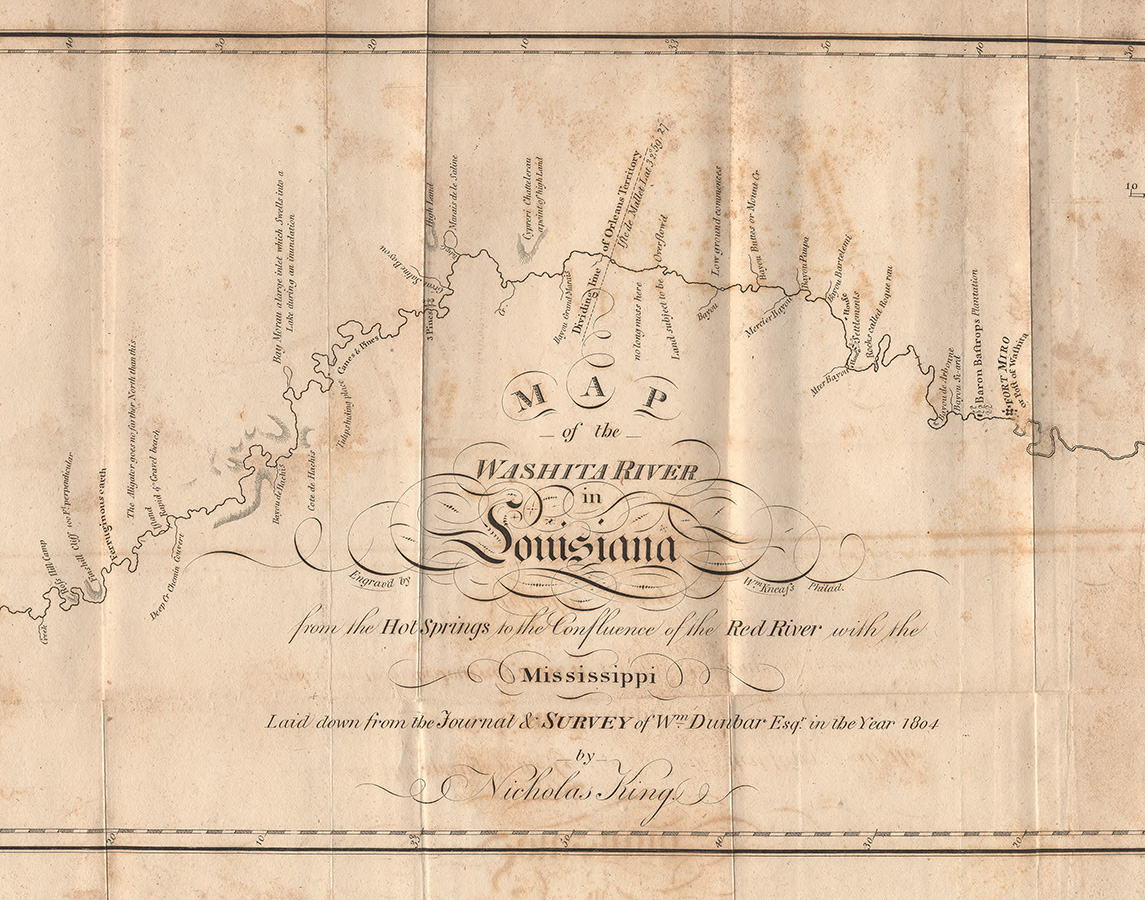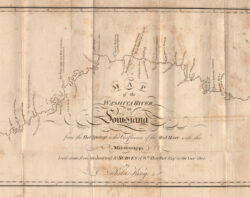Dunbar-Hunter Expedition
Thomas Jefferson commissioned the Dunbar-Hunter Expedition to explore and document the lower regions of the Louisiana Territory.
This entry is 7th Grade level View Full Entry

Library of Congress
Map of the Washita River in Louisiana from the Hot Springs to the confluence of the Red River with the Mississippi, 1804.
What was the Dunbar-Hunter Expedition?
The 1804–1806 expedition of Meriwether Lewis and William Clark from St. Charles, Missouri, to the Pacific Northwest—also known as the Corps of Discovery—is considered a milestone in North American exploration. By President Thomas Jefferson’s order, Lewis and Clark explored the vast, unknown regions west of the Mississippi River and documented the geography, natural resources, and Indigenous cultures there. However, their voyage wasn’t the only one to explore the newly acquired Louisiana Purchase territory. At the same time, Jefferson planned and launched a southern version of the Corps of Discovery. The exploration in the lower regions of the Louisiana Territory was led by two prominent Scottish immigrants, William Dunbar and Dr. George Hunter. This exploration was originally intended to trace the Arkansas and the Red Rivers to their sources. If it had succeeded as originally planned, it could have rivaled the Lewis and Clark expedition in scope. However, because of concerns about warring Osage Indians, Jefferson redirected Dunbar and Hunter to explore the Ouachita River instead. Though it was scaled back, the modified expedition still provided valuable scientific and geographic information.
Who were the explorers on the Dunbar-Hunter Expedition?
William Dunbar was born to an aristocratic family in Morayshire, Scotland. He was educated in Glasgow and London, and he had a lifetime love of the sciences. Seeking adventure, he sailed to Philadelphia, Pennsylvania, at the age of twenty-two. Two years later he established a plantation near Baton Rouge, where he deployed enslaved laborers in a variety of agricultural activities. He also participated actively in the slave trade. Dunbar later moved upriver, below Natchez, and acquired two plantations that totaled almost four thousand acres. Always experimenting with progressive farming practices, he became well known throughout the region for his business and scientific knowledge. He was a surveyor for the Spanish government and invented an unusual type of cotton press. Scientists traveling in the wilderness of the Lower Mississippi Valley frequently visited Dunbar at his plantation home and sought his advice. Hearing of Dunbar’s reputation, Jefferson nominated him to the American Philosophical Society. After several years of correspondence between the two men, Jefferson became convinced that Dunbar was the person to lead the southern expedition.
George Hunter was also born in Scotland, but his family wasn’t as wealthy as Dunbar’s. As an apprentice, he learned the apothecary trade and brought those skills to America in 1774. He enlisted in the Continental Army during the American Revolution and participated in the Battles of Princeton and Trenton. After the war he worked as a ship’s surgeon before marrying and then engaging in a variety of successful businesses as a chemist, apothecary, and trader. He occasionally took exploratory trips into remote areas of Kentucky and Illinois. As with Dunbar, Jefferson knew Hunter’s reputation. On April 15, 1804, Jefferson wrote a letter to Dunbar asking that he lead an expedition to explore the Red and the Arkansas Rivers. In it he stated that Dr. George Hunter would be his partner and chief counsel.
How did Hunter and Dunbar prepare for the expedition?
Congress appropriated three thousand dollars for the Dunbar-Hunter expedition. Hunter immediately began preparations to obtain a suitable boat and other supplies in Pittsburgh, Pennsylvania. As for the boat’s design, Hunter wrote: “This boat is 50 feet long on deck, 30 feet straight Keell, flat bottom somewhat resembling a long Scow … and furnished with a Stout Mast 36 feet long a sail 24 feet by 27 in the Chinese stile [sic].” The boat turned out to be impractical for navigating shallow southern rivers. Meanwhile, Dunbar began researching the proposed expedition by interviewing people with regional knowledge. Jefferson and Dunbar began to doubt the likelihood of a successful trip up the Red and the Arkansas Rivers, where there were increasing reports of dangers posed by a band of Osage Indians. There was also concern that Spanish authorities might challenge foreigners traveling through territory they claimed as their own. Concerned about the crew’s safety, Jefferson decided to postpone the expedition. Instead Dunbar suggested a scaled-down mission to explore the Ouachita River to its presumed source in a mountain valley that was purportedly rich in minerals and healing hot springs. Jefferson agreed.
On October 16, 1804, the crew departed from St. Catherine’s Landing, just below Natchez, pushing off into the Mississippi River. The party, which had enough supplies to last three months, consisted of Dunbar, two enslaved people owned by Dunbar, a servant, Hunter, Hunter’s teenage son, and thirteen enlisted soldiers.
What challenges did Hunter and Dunbar experience and what information did they learn on the expedition?
To access the Ouachita River, the party had to travel down the Mississippi River to the mouth of the Red River. Then they had to proceed upstream to the Red River’s intersection with the Black River. Along the way, Dunbar and Hunter recorded the latitude; a description of soils, native plants, and animals; and the general progress of their mission. Just before reaching the mouth of the Black River, the group captured a man named Harry, who they suspected of running away from slavery. By the time they entered the Black River on October 19, the leaders had realized there were two problems that could jeopardize the trip. First, the boat wasn’t fit for efficient travel on the shallow, meandering rivers. Second, without an officer onboard to encourage discipline, the soldiers were unwilling to perform the hard labor necessary to keep the heavy craft moving upstream.
The expedition reached Troyville, a prehistoric Native American mound complex, on October 23. A Frenchman who operated a ferry between Natchez and the Red River country and lived on the tallest mound gave them information about the area. He told them Fort Miro was fifty-three miles away and that shallow rapids were present between them and this first wilderness settlement. That evening, the party set up camp at the mouth of the Ouachita River (spelled “Washita” at the time).
When the party reached the rapids on October 26, the rapids were only a foot deep, but their boat needed water at least two and a half feet deep to pass through them. They tried to make a trench so they could move their boat through it, but doing so didn’t work. Hunter complained that “the men seemed jaded or unwilling to work at it.” On October 30 the boat was hailed by a man claiming to be Harry’s enslaver, and Harry was handed over to him. On November 6, after the uncooperative crew struggled upstream through frequent shoals, the party made it to Fort Miro (formerly Ouachita Post, and now Monroe, Louisiana).
The following day Dunbar wrote: “Finding from past experience that the boat in which we have come up would be improper for the continuation of our voyage, we made enquiry this morning for other craft, but it appears there is no great choice of boats at this place.” They eventually found a large, shallow-draft barge for rent, but this new boat almost sank after they transferred their supplies into it. After sealing up the boat with caulk, they continued on November 12 and soon passed the site of a land settlement founded by the Dutch businessman Felipe Enrique Neri, the so-called Baron de Bastrop. On November 15 the explorers crossed the modern border between Louisiana and Arkansas.
The new, shorter boat made travel faster. Hunter and Dunbar continued gathering data on position, air and water temperature, water depth, channel width, and the biodiversity of their surroundings. The crew often supplemented their basic food supply with wild turkeys, ducks, and other waterfowl killed along the way. Then on November 22, near present-day Camden, Arkansas, tragedy struck. While reloading his pistol, Hunter was nearly killed when the gun slipped from his grip, discharged, and propelled the bullet and ramrod and through his hand, missing his forehead by less than an inch. His thumb and two fingers were badly injured, and the blast caused partial blindness and facial burns that disabled him for two weeks.
As the party continued up the Ouachita River, passing the intersection of the Little Missouri River, the alluvial soils and sandbars turned to gravel bottoms and rock outcrops. Shoals and rapids increased, so the soldiers had to tow the boat upstream. They encountered occasional parties of hunters. Finally, on December 6, near the mouth of Fourche au Calfat (Caulker’s Creek), the expedition left the river and started to travel on land. A guide hired at Fort Miro who was familiar with the region led the group overland nine miles to the hot springs (in present-day Hot Springs, Arkansas).
For a month the expedition camped at the hot springs while Dunbar and Hunter conducted scientific research. Dunbar performed astronomical observations and Hunter analyzed the water chemistry. They made trips into the surrounding hills to assess minerals and geographic features. As winter hardened with frequent snowstorms, the party hauled their equipment back to the river and waited for the water to rise so they would have an easier time navigating the downstream rapids. On January 8, 1805, they departed downstream and homeward.
The return voyage was relatively uneventful and much faster than the upstream struggle. The party crossed into what is now Louisiana on January 14; they arrived at Fort Miro at noon on January 16. Anxious to reach home, Dunbar, his servant, and a soldier separated from the group at Fort Miro and hurried on to Natchez via canoe and horseback. He arrived on January 26. Hunter and the remainder of the group returned the rented barge and carried on in their original, oversized vessel, arriving at Natchez on January 31.
In the months following, Dunbar and Hunter prepared their reports and finalized their journals for submission to Jefferson. The president relayed the information to Congress, and in 1806 a detailed account of the expedition was published in Message from the President of the United States, Communicating Discoveries Made in Exploring the Missouri, Red River, and Washita, by Captains Lewis and Clark, Doctor Sibley and Mr. Dunbar with A Statistical Account of the Countries Adjacent.
Why is the Dunbar-Hunter expedition significant in US history?
The expedition’s accomplishments, though on a much smaller scale than those of Lewis and Clark’s epic journey, were nonetheless noteworthy. Dunbar and Hunter gathered geographic data on a wilderness region that was later compiled into an accurate map. They were the first to scientifically document the marvels of the hot springs. Their observations provided valuable insight into the flora and fauna of the Ouachita River valley while it was still pristine. They verified that the area was already well known and traveled by commercial hunters and traders, therefore leading the way for future US settlements. Concerning the expedition’s role in the exploration of the Louisiana Purchase territory, Jefferson wrote to Dunbar on May 25, 1805: “For this we are much indebted to you, not only for the labor and time you have devoted to it, but for the excellent method of which you have set the example and which I hope will be the model followed by others. We shall delegate with correctness the great arteries of this great country. Those who come after will extend the ramifications as they become acquainted with them, and fill up the canvas we begin.”
